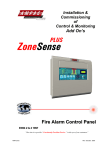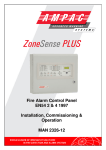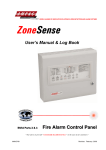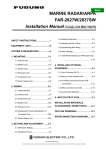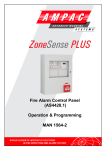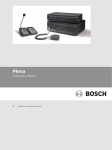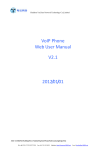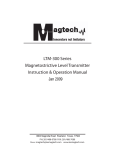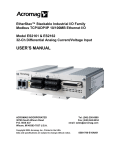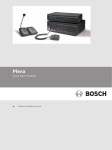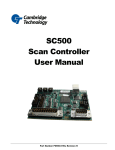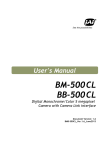Download Fire Alarm Control Panel User Manual & Log Book EN54 2 & 4 MAN
Transcript
ZoneSense Fire Alarm Control Panel User Manual & Log Book EN54 2 &4 MAN 2748-11 Responding To An Alarm Access Level 1 (Normal Operation) 1. Indicators FIRE Zone FIRE Alarm Indicator - flashing Common FIRE Alarm Indicator – flashing ZONE 1 ZONE 2 FIRE 2. To Silence the FACP Buzzer Press SILENCE BUZZER 3. To Silence External Sounders Enter Access Level 2 – Key in Password - 3, 2, 1, 0 Press SILENCE RESOUND CONTROLS ENABLED indicator - steady CONTROLS ENABLED 4. Indicators Zone FIRE Alarm indicator – steady Common FIRE Alarm indicator – steady REMOTE OUTPUT ON indicator – steady FIRE OUTPUT ON and Disabling the Alarm Zone/s 1. Enter access Level 2 2 Press 0 DISABLE / ENABLE Zone 1 Selected. Press NEXT to select Zone in FIRE 2 Then DISABLE / ENABLE to Disable 2. To Disable Zone FIRE Alarm 3. Indicators ZONE 3 Zone DISABLED Indicator – flashing then steady DISABLED Common DISABLED Indicator – flashing then steady 3 Press EXIT to EXIT the ENABLE / DISABLE mode and Access Level 2 4. Indicators - Zone DISABLED Indicator –steady Common DISABLED Indicator –steady DISABLED CONTROLS ENABLED Indicator – off CONTROLS ENABLED Resetting the Panel Press RESET ZONE 4 FAULT / DISABLED / TEST RESETS FACP (ZONE ALARM) Note: Audible feedback will be given for each button press. TABLE OF CONTENTS 1 2 3 Page No. About This Manual ............................................................................................................... 1 1.1 Purpose ................................................................................................................ 1 1.2 Scope.................................................................................................................... 1 1.3 References............................................................................................................ 1 1.4 Symbols ................................................................................................................ 1 Introduction .......................................................................................................................... 2 9 Mechanical............................................................................................................................ 3 3.1 Locating the FACP ................................................................................................ 3 3.2 PCB Removal / Replacement ................................................................................ 3 3.3 Removing the Knockouts ....................................................................................... 3 3.4 Fixing the Chassis to the Wall ................................................................................ 4 Electrical ............................................................................................................................... 6 4.1 Introduction ........................................................................................................... 6 4.2 Mains wiring .......................................................................................................... 6 4.3 Connecting the Mains ............................................................................................ 6 4.4 Cable Types and Limitations.................................................................................. 6 Power Supply ....................................................................................................................... 7 5.1 Primary Power Supply ........................................................................................... 7 5.2 Standby Power Supply .......................................................................................... 7 5.2.1 Setting Battery Monitoring....................................................................... 7 5.3 Power Faults ......................................................................................................... 7 5.4 Power Management .............................................................................................. 8 5.5 Powering Up and Down Sequence – Batteries Fitted ............................................. 8 Connecting to and Operation of the Main Control Board ................................................... 9 6.1 Optional Key Switch .............................................................................................. 9 6.2 Communications (TB400 / CN400) ........................................................................ 9 6.3 Inputs (TB1) .......................................................................................................... 9 6.4 Zone Circuits (TB2 & TB800) ............................................................................... 10 6.4.1 Operating Conditions ............................................................................ 10 6.4.2 Detector Removal Facility ..................................................................... 11 6.5 Outputs – Monitored Alarm Outputs (TB3, TB801) ............................................... 11 6.6 Outputs – Open Collector (TB4)........................................................................... 12 6.7 Remote Output – (TB4/1) .................................................................................... 12 6.8 Fault Output – (TB4/2) ......................................................................................... 12 6.9 Ancillary Output – (TB4/3) ................................................................................... 12 6.10 Reset – (TB4/4) ................................................................................................... 12 6.11 Auxiliary Power Output – (TB4/5)......................................................................... 12 6.12 Outputs – Volt Free Relay (TB5) .......................................................................... 12 6.12.1 Remote Output Relay ........................................................................... 12 6.12.2 Fault Output Relay................................................................................ 13 6.13 Watchdog Circuitry .............................................................................................. 13 6.14 Checksum ........................................................................................................... 13 6.15 Enabling and Setting Delay Timing ...................................................................... 14 6.16 Setting the Zone Configuration DIP Switches ....................................................... 14 6.17 Summary of Main Card Terminations ................................................................... 15 FACP Front Panel Controls and Indicators ....................................................................... 16 7.1 Access Levels and Passwords ............................................................................ 16 Ancillary Modules............................................................................................................... 18 8.1 Programming Ancillary Modules .......................................................................... 18 8.2 8 Way Relay Board ............................................................................................. 18 8.3 LED Annunciator Master (LAM) Card................................................................... 19 8.4 Summary of Typical Ancillary Board Specifications .............................................. 20 Configuration...................................................................................................................... 21 10 Compatible Devices ........................................................................................................... 22 4 5 6 7 8 11 Calculating Standby Battery Capacity............................................................................... 23 12 Trouble Shooting................................................................................................................ 24 13 Definitions .......................................................................................................................... 26 14 Glossary of Terms .............................................................................................................. 27 15 Specifications ..................................................................................................................... 28 ZONESENSE EN54 INSTALLATION COMMISSIONING & OPERATION 1 About This Manual 1.1 Purpose This manual is an instructional tool for the installation, commissioning, programming / reprogramming and operation of the ZoneSense Fire Alarm Control Panel (FACP). 1.2 Scope The ZoneSense FACP has been designed and manufactured from high quality commercial components so as to comply with major world standards. To ensure these standards are not compromised in any way installation staff and operators should; Be qualified and trained for the task they undertake; Be familiar with the contents of this manual prior to the installation, commissioning or operation of a FireFinder control system; Observe anti-static pre-cautions at all times; and Be aware that if a problem is encountered or there is any doubt with respect to the operational parameters of the installation the supplier should be contacted. 1.3 References This manual explains how to install and commission the ZoneSense FACP and should be read in conjunction with User’s Manual and Log Book that accompanies the panel. Documents related to the design, manufacture and installation of the ZoneSense FACP are; EN54 Pt 2 Fire detection and fire alarm systems - Control and Indicating Equipment EN54 Pt 4 Fire detection and fire alarm systems - Power Supply Equipment BS 5839 – 1: 2002 Fire detection and alarm systems for buildings Code of practice for system design, installation and servicing. 1.4 Symbols Important operational information Note: Configuration considerations Observe antistatic precautions Mains supply earth DANGER mains supply present Page 1 ZONESENSE EN54 INSTALLATION COMMISSIONING & OPERATION 2 Introduction The ZoneSense Fire Alarm Control Panel (FACP) is supplied in an ABS (with a surround for recessed mounting) or metal cabinet as a two, four or eight zone Conventional FACP and can have up to four (4) remote LED Annunciator Cards (LAM’s) Order Code 43100-0037 and / or one (1) 8 Way Relay Board Order Code 4310-0050 [internal] 4310-0055 [external]. ZoneSense meets the EN54-2 and EN54-4 standards, complies with the optional clauses 7.8 (Output to fire alarm devices), 7.11 (Delays to outputs) 10 (Test condition) and offers limited on site programming and operational test facilities. Features include; Controls that have tactile and audible feedback of operation. On-site programming. Terminals cater for up to 2.5mm diameter cables. Buzzer Operation The buzzer provides audible: Indication at system start-up (3 tone bursts of increasing frequency) Indication of a fire condition. Tone is continuous, until the buzzer is silenced or the fire condition is cleared by reset. Indication of a fault condition. Tone is 1 second on, 1 second off, until the fault condition clears. Feedback when a key is pressed. Feedback when multiple keys are pressed simultaneously or illegal key press (for example RESET when at access level 1) or there is a timeout condition entering the password. The buzzer: Is silenced by SILENCE BUZZER but will resound on any new alarm or fault condition. Sounds during a lamp test. Sounds (fault indication), when the power supply is not calibrated. Sounds when calibration is successful (same tone bursts as at system start-up) Page 2 ZONESENSE EN54 INSTALLATION COMMISSIONING & OPERATION 3 Mechanical The ZoneSense FACP has an ABS (BX1) or Metal (BX10) enclosure that meets IEC529:1989 IP30 classification. The enclosure houses the Main Control Board (which has all the controls / indicators, power supply / battery charger circuitry mounted directly onto it), mains transformer and batteries. All can be easily removed to allow the cabinet assembly to be fixed to the building structure without obstruction. 3.1 Locating the FACP The FACP MUST be installed in an area that is NOT subject to conditions likely to affect its performance e.g. damp, salt-air, water ingress, extremes of temperature, physical abuse, etc. It should be: At eye height; Easily accessible; and In a prominent position within a building. Typical locations are the first and most obvious point of contact for emergency services, e.g.; an entrance foyer; the hallway of a building at ground floor level; or a security situation that is likely to be permanently monitored. 3.2 PCB Removal / Replacement If the PCB has to be removed the following precautions must be observed; Removing the door will provide better access to the board/s and ensure the hinges are not accidentally stressed. To remove swing the door open and push upwards at the hinges as indicated in the following assembly drawing. Personal anti- static procedures must be followed. Disconnect all wiring; carefully remove the retaining screws at each corner of the bridge all the while taking care not to damage any of the components. Place the bridge into an anti - static storage once removed. 3.3 Removing the Knockouts Carefully decide how the wiring will be brought into the panel then remove the required knockouts for the bushes and cabling. The knock-outs should be removed with a series of sharp taps around the rim of the knock-out impression using a flat broad-bladed screwdriver. Exercise some care during this process as the use of excessive force could damage the enclosure around the knock-out. If a knock-out is removed always ensure, the hole is filled with a good quality cable gland. Any unused knock-outs must be securely blanked off. REMOVING KNOCKOUTS Figure 1: Removing Knockout Page 3 ZONESENSE EN54 INSTALLATION COMMISSIONING & OPERATION 3.4 Fixing the Chassis to the Wall Refer to the diagrams of the panel showing a Typical FACP Layout. If necessary remove the batteries to expose the lower mounting keyhole. Taking into account the total weight of the panel securely mount it by using the three keyhole mounting holes using suitably sized screws and plugs for the type of mounting surface while at the same time ensuring any dust or swarf created during the fixing process is kept out of the panel BRIDGE RETAINING SCREWS BRIDGE MARKING ON THE ENCLOSURE INCLUDES; AMPAC'S NAME AND TRADEMARK MODEL NUMBER PRODUCTION LABEL ( BATCH NUMBER / BUILD PERIOD ) TOP KNOCKOUTS PCB FIXING SCREWS MAIN CONTROL BOARD CONTROL PANEL ASSEMBLY DECAL BACK KNOCKOUTS TO REMOVE THE DOOR OPEN TO 90 DEGREES AT THE HINGES AND PUSH UPWARDS HERE KEY ID LABEL BATTERY SHELF EXPLODED ISOMETRIC VIEW FRONT VIEW Figure 2: Exploded Views of ABS (BX1) Cabinet, Decal, Bridge and PCB Note: The Metal (BX10) cabinet is assembled in the same fashion The BX1 front door is locked by way of two clips on the right hand side of the cabinet. A special locating key which has two raised pins that are inserted into the side of the cabinet unlocks the door. The BX1 can also be supplied with a 003 Key Lock if required. The BX10 box is locked with a 003 Key. AM PA C DOOR RELEASE PINS DOOR RELEASE PINS Figure 3: Plastic Key Page 4 ZONESENSE EN54 INSTALLATION COMMISSIONING & OPERATION 163.20 mm 147.00 mm 147.00 mm Figure 4: ABS (BX1) Mounting Points 230.90 mm 288.40 mm Figure 5: Metal Cabinet (BX10) Mounting Points Page 5 ZONESENSE EN54 INSTALLATION COMMISSIONING & OPERATION 4 Electrical 4.1 Introduction The FACP consists of the Main Control Card and mains transformer. The control board is broken into two sections, the main control circuitry and the power supply / charger. FUSE BLOCK 0.5A M205 FRONT DOOR (REMOVED) ABS BRIDGE BRD22MCB PCB0758 MAIN CONTROL BOARD (REAR VIEW) CHASIS EARTH TERMINAL MAINS TRANSFORMER BATTERY CONNECTION WHITE SERIES WIRE -VE (B1) TO +VE (B2) CN4 CN3 CN2 TO REMOVE THE DOOR UNPLUG CABLES AND PUSH UPWARDS HERE RED TO +VE (B1) DOOR HINGES X4 BLACK TO -VE (B2) BATTERY 2 (B2) BATTERY 1 (B1) CAB2797 TO BATTERIES 32VAC Figure 6: Battery Connection & General Wiring Diagram 4.2 Mains wiring The requirement for the ‘Mains’ supply to the Fire Alarm Control Panel is three core cable ( no less than 1mm and no more than 2.5mm ) fed from a fused 3A isolating switched spur which should be secured from unauthorised operation and be marked 'FIRE ALARM: DO NOT SWITCH OFF’. 4.3 Connecting the Mains The incoming Mains cable should be brought into the Panel at the top right hand side of the enclosure and correctly terminated to the fuse / terminal block. Wired to this terminal block is the mains transformer that reduces the mains to the required 32VAC secondary voltage. Before switching on the Power Supply the Earth MUST be connected to the chassis earth terminal as shown in the following diagram. All earth cabling must be terminated to the Panels Chassis Earth Terminal in a Star configuration. Each additional earth cable must be terminated with an M4 nut and M4washer. An additional M4 nut and washer are fitted to the earth terminal for installers to connect their mains earth NEUTRAL EARTH LIVE CHASSIS EARTH TERMINAL M4 NUT M4 WASHER M4 NUT EARTH CABLE TO MAINS TRANSFORMER Note: Top M4 Nut and M4 washer are provided Mains Supply Earth connection. M4 WASHER M4 NUT EARTH CABLE CAB2875 TO EARTH OUTPUT OF TERMINAL FUSE BLOCK FUSE = 0.5A M205 MAINS TRANSFORMER Figure 7: Chassis Earth Terminal Connection 4.4 Cable Types and Limitations All System wiring should be installed to meet Wiring Regulations. Other National standards of installation should be used where applicable. To shield the Panel from outside interference and ensure compliance with Electro Magnetic regulations screened cables can be used throughout an installation. Page 6 ZONESENSE EN54 INSTALLATION COMMISSIONING & OPERATION 5 Power Supply The power supply equipment (PSE) consists of a primary power supply and battery standby if required. The primary power supply derives the appropriate voltages to run the FACP and charge the batteries (if fitted) from the available mains supply. In the event of a failure of the mains supply the PSE automatically switches over to the standby rechargeable sealed lead acid batteries to power the FACP. During this time the FACP will indicate there is a power fault (Power Fault LED flashes) and continue to function normally. When the mains is restored the PSE automatically switches back to the primary power source. If the mains interruption is of such duration that the standby battery capacity is reduced to such a level as dictated by the battery manufacturer the FACP will shut down. The maximum size batteries that can be accommodated within the enclosure are 7A/Hr. 5.1 Primary Power Supply The primary power supply operates from 204 to 265VAC, is capable of producing a nominal 24VDC at up to 1.6 amps. It consists of a transformer mounted to the rear of the enclosure and appropriate circuitry located on the control card. A DC to DC converter converts the 24VDC to 3.3VDC to power the FACP microprocessor. 5.2 Standby Power Supply The optional backup battery supply is required to be able to maintain FACP quiescent operation for 24 hours (72 for non monitored applications) in the event of mains power failure, then supply full alarm load for a period of 30 minutes. The standby power supply has a low voltage disconnect to prevent the batteries from being discharged below 21VDC. Requirements of the battery charger are to: Ensure the batteries are charged according to the manufacturers specifications. To provide a facility to measure the battery voltage, and detect a missing or damaged battery To provide a facility to turn off the charger output. To provide a facility to measure the charger voltage To ensure the battery connection is protected against reverse or short circuit connection To ensure the battery does not discharge through the battery charger, when the charging voltage is less than the battery voltage. 5.2.1 Setting Battery Monitoring If the optional backup battery supply is not fitted to the FACP the battery monitoring is disabled (at access level 3) by using switch 1 of the 4 way DIP switch SW10. Switch is ON to enable monitoring, and OFF to disable monitoring. 5.3 Power Faults Power faults are detected within 10 seconds and displayed by the FACP. Faults detected are; Loss of mains and if batteries are fitted and monitoring enabled. Missing or damaged batteries Battery voltage below 21.6V Charger voltage in excess of 28.8VDC Loss of charger voltage Page 7 ZONESENSE EN54 INSTALLATION COMMISSIONING & OPERATION 5.4 Power Management The following is the current requirements of the panel. Requirement Battery Charger 8 x Zones @ 25mA (in alarm) 8 x Zones @ 2mA (normal) 4 x Monitored Outputs (250mA each) 24VDC Common for O/C outputs Aux 24VDC FACP electronics In the quiescent state, current requirements are: Requirement Battery Charger (assume max charge) 8 x Zones @ 2mA (normal) Aux 24VDC FACP electronics Total Current 234mA 200mA 16mA 1000mA 170mA 150mA 20mA Current 234mA 16mA 150mA 20mA 425mA Note: For a 2 zone panel, the zone current requirement is 4mA, making a total of 413mA, and is 8mA or 417mA for a 4 zone panel. In the alarm state current requirements are; (assume all 8 zones in alarm, and charger disabled) Requirement Current 8 x Zones @ 25mA (in alarm) 200mA 4 x Monitored Outputs (250mA each) 1000mA 24VDC Common for O/C outputs 170mA Aux 24VDC 150mA FACP electronics 20mA Total 1545mA For the 2 zone panel, 50mA is required for the zones, 500mA for the monitored outputs (2 fitted) plus the normal operational current totals 895mA. For the 4 zone panel, 100mA is required for the zones, and 500mA for the monitored outputs (2 fitted), plus the normal operational current totals 945mA. 5.5 Powering Up and Down Sequence – Batteries Fitted Given the current involved on “power up” the following procedure MUST be followed; Power Up Connect the batteries – white cable +ve red terminal to black terminal –ve ( places the batteries in series ) red cable to red + ve terminal, black cable to –ve black terminal. Switch on the mains supply Power Down Switch off the mains supply Remove the positive (+ve) lead from the batteries Note: After a “Power Down” the mains supply and batteries MUST be left disconnected for at least 1 minute to allow any residual capacitive charge to be dissipated. If this process is not followed a SYSTEM FAULT could be incorrectly indicated Page 8 ZONESENSE EN54 INSTALLATION COMMISSIONING & OPERATION 6 Connecting to and Operation of the Main Control Board The Main Control Board provides a range of different field terminations – inputs, zone circuits, monitored outputs, voltage free outputs (relay), communications, open collector outputs and can include an optional controls enable front panel mounted key-switch. ON ON 1 SW11 2 3 4 5 6 SW10 7 8 1 2 3 4 TB400 RS485 + - SHLD TB1 I/P's C CC ALT + - + - TB2 + ZONES 1 - 4 + - + - + - TB800 + ZONES 5 - 8 + 8 ZONE ONLY 4 ZONE ONLY SW800 - TP33 ALARMS O/P's 1 & 2 + - + - ALARMS O/P's 3 & 4 + - + - TB3 TB801 REM ANC AUX+ FLT RST TB4 TP14 FAULT REMOTE OUTPUT OUTPUT NO C NC NO C NC AUX 24VDC + - TB5 TB6 ALARM RELAY FIRE REMOTE OUTPUT DISABLED POWER POWER FAULT SYSTEM FAULT CN400 RS485 COMMS IN/OUT CONTROLS ENABLED AUXILIARY POWER FAULT ZONE 2 FAULT OUTPUT STATUS ZONE 3 ZONE 4 AUXILIARY OUTPUT DISABLED ZONE 5 ZONE 6 TEST ZONE 7 ZONE 8 FAULT/DISABLED/TEST REMOTE OUTPUT ON ALARM STATUS DELAY ACTIVE OVERRIDE SILENCE RESOUND BZ1 RL2 RL1 ZONE 1 FAULT RELAY FAULT FIRE SILENCE BUZZER KEYSWITCH CUT OUT DISABLED EVACUATE RESET NEXT LAMP TEST DISABLE/ ENABLE EXIT BATTERY KEYSWITCH CN3 CN2 ENABLE DISABLE CN4 28VAC Figure 8: Main Board Layout 6.1 Optional Key Switch The keyswitch is optional and if fitted provides keyed level 2 access. 6.2 Communications (TB400 / CN400) RS485 communications allows the Main Control Board to communicate with the internal and / or external ancillary boards but is only fitted to the 4 and 8 zone FACP’s. The external communication are protected to meet the relevant standards, consists of three terminals, A, B & Shield and drives a maximum of four (4) LAM's and one (1) 8 Way Relay Board. A B SHLD TB400 RS485 + F IRE To LAM/s and or 8 Way Relay Board - SHLD FAULT/DISABLED/TEST CN2 CN3 Note: Terminal block ( communications ) is only fitted to the 4 and 8 zone FACP's CN400 is Located on the Back of the Main Board Figure 9: TB400 Termination & Location on the Main Control Card 6.3 Inputs (TB1) Common Terminal Used for inputs requiring a 0V potential to initiate a change of state in an output. Class Change Input This input allows a remote voltage free, closing set of contacts to operate the Alarm outputs. The non-latching input is active when it is pulled down to 0v potential. When active the Alarm Outputs will operate continuously, no visual indication is given and no other output shall operate. Alert Input This non-latching input allows a remote voltage free, closing set of contacts to operate the Alarm outputs. The input is active when it is pulled down to 0v potential. When active the Alarm Outputs will pulse at a rate of 1sec on 1 sec off, no visual indication is given and no other output will operate. Page 9 F I RE Class Change (CC) Input FAULT/DISABLED/TEST CN2 CN3 ZONESENSE EN54 INSTALLATION COMMISSIONING & OPERATION 0V TB1 I/P's C CC ALT Figure 10: TB1 Typical Class Change / Alert Input Termination & Location on the Main Control Card 6.4 Zone Circuits (TB2 & TB800) A maximum of 32 x 24volt Optical / Heat Detectors and / or Manual Call Points mixed in any order can be fitted to each circuit. An output current of 4mA for each circuit with capacitive EOL is considered to normal and in a worst case or fault S/C condition each circuit is current limited to a maximum of 25mA. The Main Control Board has up to eight (8) zone circuits that connect to the 24VDC conventional fire detectors. The maximum number of detectors and MCP’s that can be supported will be influenced by the quiescent current draw of the detectors and MCP’s being fitted. The wiring for each zone circuit should be connected to the relevant terminal block on the Main Control PCB and if screened the screens terminated at the panel's base earth post. An End of Line 10F Bi-polar Capacitor must be connected across the terminals of the last device on each circuit to allow the circuit to be monitored. Zones that are not used must also have an End of Line capacitor fitted to the terminal block at the panel. The detector interface is compatible with Apollo and Hochiki conventional detectors (refer to the list of compatible devices). Reset time is 2 seconds. Each zone circuit will function as follows. Reported Condition Disable Fault Alarm Fault Normal Comment When the zone circuit has been disabled. Short circuit exists on the zone circuit One or more detectors have been activated EOL capacitor is not detected (O/C condition), detector removed All detectors are normal and EOL capacitor is connected APOLLO SERIES DIODE BASE WIRING CN2 CN3 MAIN CARD FIRE FAULT/DISABLED/TEST L1 In TB -R -R L1 In + L1 In 2 800 -R + + L1 Out L1 Out - EOL Earth L2 - Earth L2 - Earth L2 The diode is used when the detector removal facility is utilised Figure 11: TB2 / 800 Detector Wiring & Location on the Main Control Card 6.4.1 Operating Conditions All zone fault conditions are non-latching hence cleared when the reset control is activated, and are re-announced within 10 seconds if the fault condition still exists. Zone alarms are only configured as latching. This means that irrespective of the condition of the zone itself the alarm condition can only be cleared when the front panel reset control is activated, Zones can also be configured to have an associated output delay timer. The delay time can be set from 30 seconds up to 7 minutes and 30 seconds. If the zone is configured with a delay then the activation of the alarm outputs and ancillary output is delayed accordingly. A front panel control is provided to override the delay. This is associated with an indicator which is illuminated when the delay timer is active. Page 10 ZONESENSE EN54 INSTALLATION COMMISSIONING & OPERATION Note: The activation of the remote output relay is not affected by the delay timer. Typically MCP’s must be fitted with series resistors (470 or 680 ohm), so as when the MCP is activated a short circuit is not present on the zone circuit. The zone circuits can be disabled by using the front panel controls Once disabled, the zones do not cause the activation of the alarm outputs, remote relay output or ancillary output. 6.4.2 Detector Removal Facility This facility allows for up to 20 detectors to be removed from their bases at any one time. If a detector head is removed a fault will be indicated on that zone and all the other devices retain the ability to initiate an alarm. This facility requires a Schottky diode to be fitted as per Figure 11 Note: Schottky diodes having a voltage drop of 0.2 – 0.3 of a volt have to be installed across L1 in and L1 out on the detector base. The limitation on the number of heads that can be removed is a direct result of the cumulative effect of the voltage drop across each diode. Diodes will not be required if the head removal facility is not required. 6.5 Outputs – Monitored Alarm Outputs (TB3, TB801) The Main Control Card has four (4) parallel PTC protected monitored outputs typically used to power electronic type sounders and are referred to as alarm outputs. Each output is nominally rated at 250mA @ 24VDC and monitored for open and short circuit conditions when the output is not activated. Monitoring is achieved by the sensing of the End of Line (EOL) 10kΩ resistors and is independent of the loading of bells and sounders. The monitoring is forward biased and requires diodes to be fitted in series with each bell and sounder. Faults on the monitored outputs will be indicated by the FACP within 60sec. CN2 CN3 10K EOL F I RE FAULT/DISABLED/TEST 10K OHM EOL RESISTORS REQUIRED TB801 TB3 + 1 - + 2 - + 3 - + 4 - Figure 12: TB3 – TB801 Termination Block with Sounder fitted & Location on the Main Control Card Note: The 2 zone and 4 zone version has 2 alarm outputs fitted while the 8 zone version has 4 alarm outputs fitted. The alarm outputs are activated by the: Class change input Alert input Front panel evacuate control, silence/resound control Zones entering the alarm condition. If there are no delays programmed the alarm outputs will be activated within 3 seconds of the zone entering the alarm condition. General Conditions Zones entering the alarm condition will always activate the alarm outputs. Alarm outputs can be de-activated by the silence/resound control and/or a reset of the zone(s) in alarm. The front panel Evacuate control will always activate the alarm outputs. Alarm outputs can be deactivated by the silence/resound control and/or a reset If the Class Change input is ON and there are no zones in alarm and the front panel evacuate control is not active, then the alarm outputs will be activated. Page 11 ZONESENSE EN54 INSTALLATION COMMISSIONING & OPERATION If the Alert input is ON, Class Change input is OFF, there are no zones in alarm and the front panel evacuate control is not active then the alarm outputs will pulse at the rate of 1sec ON and sec OFF. The Alarm outputs can be disabled by using the front panel control. Once disabled, the outputs will remain off until they are re-enabled. A front panel indicator associated with the output is illuminated when these outputs are disabled. 6.6 Outputs – Open Collector (TB4) There are four unmonitored open collector type outputs. Each output is capable of switching 40mA of output current and withstand a short circuit condition to the common +24VDC output without damage. Note: The common +24VDC feed is current limited to 170ma by a PTC and monitored at the CN2 AUX + F I RE RST ANC 15 Sec Reset +24v / 100mA 0v Pulse FLT TB4 FAULT/DISABLED/TEST BACK EMF PROTECTION DIODE CN3 terminal block. If there is an over current situation, then the PTC will activate and a fault will be reported at the FACP REM Figure 13: TB4 Remote, Fault, Ancillary Reset, Auxiliary Output Terminations, Reset Pulse & Location on the Main Control Card 6.7 Remote Output – (TB4/1) The operation of this output is identical to the operation of the remote output relay. 6.8 Fault Output – (TB4/2) The operation of this output is identical to the operation of the fault output relay. Note: This output will be normally energised, and de-energised to signify a fault condition. 6.9 Ancillary Output – (TB4/3) Ancillary Output is a un-monitored open collector output activated when any of the zones report an alarm condition. The activation of this output is subject to any delays that may be configured. This output can be disabled by using the front panel controls. Once disabled the output will remain off until it is re-enabled. The ANCILLARY OUPUT front panel indicator is illuminated when this output is disabled. 6.10 Reset – (TB4/4) Reset is a non-monitored open collector output activated for 15sec with the FACP reset. 6.11 Auxiliary Power Output – (TB4/5) This +24VDC output with an associated return is monitored at the terminal block and current limited to 150mA @ 24VDC by a PTC. If an over current situation occurs fault will be indicated. 6.12 Outputs – Volt Free Relay (TB5) There are two voltage free relay outputs, the Remote output, and the Fault output. 6.12.1 Remote Output Relay The Remote Output Relay has 1A 30VDC unmonitored voltage free single change over contacts that are activated when any zone circuit reports an alarm condition. The front panel indicator “Remote Output On” is illuminated when the output is activated and is reset via the front panel reset control. Page 12 ZONESENSE EN54 INSTALLATION COMMISSIONING & OPERATION The output can also be disabled by using the front panel controls. Once disabled the relay will remain off until re-enabled and the front panel indicator “Remote Output Disabled” is illuminated. 6.12.2 Fault Output Relay The Fault Output Relay is energised if the FACP is operating normally and has unmonitored 1A 30VDC voltage free single change over contacts. The output can be disabled by using the front panel control. Once disabled the relay will remain on until it is re-enabled and the FAULT OUTPUT front panel indicator is illuminated when this output is disabled. If a fault is present on the FACP the output relay is de-energised and remains de-energised until the fault conditions have cleared. There are a number of front panel fault indicators that detail the nature of the fault. These are: Power Fault – fault relating to the power supply. System Fault – fault relating to the operation of the FACP. Auxiliary Power Fault – fault relating to the auxiliary power output. Individual zone fault indicators. Alarm Outputs. Faults associated with ancillary modules – missing, type mismatch or extra. Note: #1: All faults are non-latching, except for system fault. Note: #2 Faults associated with zones are cleared on a reset condition. Note: #3 Power faults are indicated RELAY CONTACT POSITIONING WHEN THE RELAY/S ARE DE-ENERGISED CN2 NORMALLY ENERGISED "ON" FAULT RELAY F IRE REMOTE RELAY "ZONE ALARM" NO: NORMALLY OPEN CN3 NC: NORMALLY CLOSED FAULT/DISABLED/TEST C: COMMON TB5 NO C NC NO C NC Figure 14: TB5 Remote and Fault Relay Termination & Location on the Main Control Card 6.13 Watchdog Circuitry The Main Control Board has watchdog circuitry external to the main processor that strobes the main processor at intervals equal to or less than 1 second. If the 1 second interval is not met the main processor is reset by the Watchdog circuitry, the system fault and common fault indicators will be illuminated and the buzzer will sound. These indicators remain illuminated until reset. If the main processor fails to successfully restart after six to twelve reset operations the processor is held in reset. In the situation where the processor is held in reset, the buzzer will sound, the system fault and fault indicators will flash at 0.25Hz, that is On for 2 seconds and Off for 2 seconds. 6.14 Checksum At periods not exceeding one hour, the main processor performs a checksum operation on the application software and configuration data. If the application software or configuration data has become corrupted then the main processor enters the reset state, the buzzer will sound, and the system fault / fault indicators will flash at 0.25Hz, that is On for 2 seconds and Off for 2 seconds. Page 13 ZONESENSE EN54 INSTALLATION COMMISSIONING & OPERATION 6.15 Enabling and Setting Delay Timing Note: Delay enabling and timing can only be set at access level 3 Enabling An 8 way DIP switch is used to enable the delays on a zone by zone basis. Switch 1 corresponds to zone 1; Switch 2 corresponds to zone 2 and so on. Switch OFF position disables delay, and the ON position enables delay. For example if switch 1 is OFF, and switch 2 is ON, then zone 1 has delays disabled, and zone 2 has delays enabled. Setting the Delay Time If delays are enabled the delay time is the same for all zones. The length of the delay is set by adjusting the 4 way DIP switch, adjustable from 0 to 8:00 minutes in steps of 30 seconds, DIP SWITCH SETTINGS Delay Value in Min: Sec 1 2 3 4 OFF OFF OFF OFF 0:30 ON OFF OFF OFF 1:00 OFF ON OFF OFF 1:30 ON ON OFF OFF 2:00 OFF OFF ON OFF 2:30 ON OFF ON OFF 3:00 OFF ON ON OFF 3:30 ON ON ON OFF 4:00 OFF OFF OFF ON 4:30 ON OFF OFF ON 5:00 OFF ON OFF ON 5:30 ON ON OFF ON 6:00 OFF OFF ON ON 6:30 ON OFF ON ON 7:00 OFF ON ON ON 7:30 ON ON ON ON 8:00 6.16 Setting the Zone Configuration DIP Switches Note: Zone configuration can only be set at access level 3 In the 2 zone version one 8 way DIP switch is fitted, switches 1 - 4 are used for setting the delay time, switch 5 enables the delays for zone 1, and switch 6 enables the delays for zone 2. The 4 zone version is the same as the 2 zone version, with the addition that switch 7 enables the delays for zone 3 and switch 8 enables the delays for zone 8. In the 8 zone version an 8 way DIP switch and a 4 way DIP switch are fitted. The 8 way DIP switch is used the same as the 4 zone version. Switch 1 of the 4 way DIP switch enables the delays for zone 5; switch 2 enables the delays for zone 6; switch 3 enables the delays for zone 7; and switch 4 enables the delays for zone 8 Switch Type Switch Function 1,2,3,4 Delay time 5 Zone 1 Delay (all models) 8 Way (always fitted) 6 Zone 2 Delay (all models) 7 Zone 3 Delay (4 and 8 zone model only) 8 Zone 4 Delay (4 and 8 zone model only) 1 Zone 5 Delay (8 zone model only) Zone 6 Delay (8 zone model only) 4 Way (only fitted on the 8 2 zone version) 3 Zone 7 Delay (8 zone model only) 4 Zone 8 Delay (8 zone model only) Page 14 ZONESENSE EN54 INSTALLATION COMMISSIONING & OPERATION 6.17 Summary of Main Card Terminations Terminal Number Terminal Description COMMUNICATIONS EXTERNAL TB400 / 1 RS485 2 RS485 3 Shield INPUTS TB1 / 1 Common 2 Class Change (Steady alarm out) 3 Alert (Pulsing alarm output) ZONES TB2 / 1 + Zone 1 2 - Zone 1 3 + Zone 2 4 - Zone 2 5 + Zone 3 6 - Zone 3 7 + Zone 4 8 - Zone 4 TB800 / 1 + Zone 5 2 - Zone 5 3 + Zone 6 4 - Zone 6 5 + Zone 7 6 - Zone 7 7 + Zone 8 8 - Zone 8 MONITORED OUTPUTS TB3 / 1 Alarms 1 + 250mA 2 Alarms 1 – 250mA 3 Alarms 2 +250mA 4 Alarms 2 – 250mA TB801 / 1 Alarms 3 +250mA 2 Alarms 3 – 250mA 3 Alarms 4 +250mA 4 Alarms 4 – 250mA OPEN COLLECTOR OUTPUTS TB4 / 1 Remote Output (40mA) 2 Fault Output (40mA) 3 Ancillary Output (40mA) 4 Reset Output (40mA) 5 24VDC + Com for O/C outputs OUTPUTS VOLT FREE RELAY ( 1A @ 24VDC ) TB5 / 1 NO Remote Output 2 C Remote Output 3 NC Remote Output 4 NO Fault 5 C Fault 6 NC Fault TB6 / 1 Aux 24VDC + (Mon 150mA) 2 Aux 24VDC AC INPUT FROM MAINS TRANSFORMER CN4 / 1 V~ 2 V~ 3 Earth CONTROLS ENABLED KEYSWITCH CN2 / 1 Common 2 Controls Enabled 8 24VDC Page 15 Terminal Operation/Build Option Used to connect to one 8 way relay card and up to four LAM’s Fitted on all models Zone Circuits 1 and 2 Fitted on all models Zone Circuits 3 and 4 Fitted on the 4 and 8 zone models Zone Circuits 5, 6, 7 and 8 Fitted on the 8 zone model Alarm outputs 1 and 2 Fitted on all models Alarm outputs 3 and 4 Fitted on the 8 zone model Fitted on all models Fitted on all models Fitted on all models Fitted on all models Current limited to 170mA Fitted on all models Fitted on all models Fitted on all models. Current limited to 150mA Fitted on all models Input from optional key-switch ZONESENSE EN54 INSTALLATION COMMISSIONING & OPERATION 7 FACP Front Panel Controls and Indicators The front panel consists of a 9 push buttons and 31 LED indicators, and an optional key-switch. 7.1 Access Levels and Passwords By default the FACP is in access level 1. Entry to access level 2 can be gained in two ways. entering a fixed digit password (3210); The password is entered by depressing the Exit key, then the Enable/Disable key, then the Lamp Test , and finally the Next key. The timing between key presses must be 10 seconds or less. If the timing between key presses is greater than 10 seconds, then the password must be re-entered. The timeout is accompanied by an error beep from the buzzer. Note: If the FACP is in access level 2 (by entering the password), and no controls are operated within 120 seconds, then the FACP will revert to access level 1. This is to ensure that there is no unauthorised operation. via the optionally fitted controls enabled key-switch. All Control Enable key switches fitted to the FACPs are keyed alike. The key is only remove-able in the off or disabled position. Operating the key switch will put the FACP into access level 2, and the Controls Enabled indicator will be illuminated steady. Provision is made on the main card to interface to the controls enabled key switch. If the key switch is not fitted, then the interface defaults to the “off” setting. Entry to access level 3 is by opening the front panel door of the FACP using a special tool. Once the door is opened, access can be gained to the level 3 access / programming push button and DIP switches located in the top left hand corner of the main board (see over for board layout). Step 1 Enter password and open door ( Controls Enabled LED illuminated ) Step 2 Step 3 Step 4 Press Press ANC PROG once to enter level 3 Press again and hold for 3 Secs to reprogram Page 16 RESET then 3 EXIT to clear SYSTEM FAULT, end programming and EXIT controls enabled ZONESENSE EN54 INSTALLATION COMMISSIONING & OPERATION ALT Input Class Change (CC) Input ANC PROGRAMMING AND ACCESS LEVEL 3 ENTRY SWITCH ON 1 SW11 2 3 4 5 SW10 6 7 8 1 2 3 4 TB400 RS485 + - SHLD +24VDC / 100mA 15 Sec Reset 0v Pulse EOL Resistor EOL Termination Values Zone = 10uF Monitored I/O's = 10Kohms LAM, 8 Way Remote DELAY DELAY Relay Board ENABLE TIME 0-7.5 Mins 1,2 - 4 / 8 Zone ON EOL Resistor EOL Capacitor Bell ALL Un-used Zones MUST be Terminated with an EOL TB1 I/P's C CC ALT + - + - TB2 + ZONES 1 - 4 - + - + - + - TB800 + ZONES 5 - 8 + 8 ZONE ONLY 4 ZONE ONLY SW800 - Warn Sys ACF ASE TP33 ALARMS O/P's 1 & 2 + + - ALARMS O/P's 3 & 4 + + - TB3 TB801 FIRE POWER POWER FAULT SYSTEM FAULT CN400 RS485 COMMS IN/OUT CONTROLS ENABLED AUXILIARY POWER FAULT DELAY ACTIVE REMOTE OUTPUT DISABLED ZONE 1 ZONE 2 FAULT OUTPUT STATUS ZONE 3 ZONE 4 AUXILIARY OUTPUT DISABLED ZONE 5 ZONE 6 TEST ZONE 7 ZONE 8 FIRE BZ1 SILENCE RESOUND SILENCE BUZZER TB4 TP14 FAULT REMOTE OUTPUT OUTPUT NO C NC NO C NC AUX 24VDC + - TB5 TB6 ALARM RELAY FAULT RELAY RL2 FAULT/DISABLED/TEST REMOTE OUTPUT ON ALARM STATUS REM ANC AUX+ FLT RST RL1 FAULT KEYSWITCH CUT OUT DISABLED NEXT OVERRIDE Front of Main Card & Illustrated External Cabling EOL Resistor EOL Resistor Maximum of 32 Devices per Zone RESET EVACUATE DISABLE/ ENABLE LAMP TEST EXIT Figure 15: Main Control Board Layout & Typical External Cabling Page 17 BATTERY C N3 KEYSWITCH C N2 ENABLE DISABLE CN4 28VAC ZONESENSE EN54 INSTALLATION COMMISSIONING & OPERATION 8 Ancillary Modules Note: Ancillary modules are only supported in the 4 & 8 zone versions. The FACP has the ability to “learn” the type and address of connected ancillary modules. There is support for 1. Four (4) LAM cards and 2. One (1) Internal or one (1) External 8 way Relay Board. LAM cards must be set to address 1 through 4 and depending on the required functionality the 8 way Relay Board set to address 1 or 2. 8.1 Programming Ancillary Modules To program the number and type of ancillary modules, connect the modules to the FACP, enter access level 3, and then depress the programming pushbutton for 3 seconds. The buzzer will beep for 1 second confirming the connected ancillary module/s have been programmed RESET Press Press ANC PROG once to enter level 3 Press and hold for 3 Secs to reprogram 3 then EXIT to clear SYSTEM FAULT, end programming and EXIT controls enabled 8 Way Relay Board The Relay Board provides 8 X 1A voltage free changeover contacts for control and or monitoring purposes and can be mounted internally or externally to the cabinet. RS485 communications / connection to the Main Control Board is via terminals TB400 1 (+ve), 2 (-ve) and 3 (Shield). The Relay Board has been designed to operate in two ways. 1. If the address of the Relay Board is set to 1 (see below), then when any zone circuit reports an alarm ALL 8 relays will be activated. 2. If the address of the Relay Board is set to 2 (see below), then: I. Relay 1 will be activated when zone circuit 1 reports an alarm; relay 2 will be activated when zone circuit 2 reports an alarm. This continues for relay 3 (zone circuit 3) up to relay 8 (zone circuit 8) II. If the relay board is connected to a 2 zone model, then relays 3 to 8 will be activated if any zone circuit is in alarm III. If the relay board is connected to a 4 zone model, then relays 5 to 8 will be activated if any zone circuit is in alarm. ON ON 1 2 3 1 2 3 Address switch set to 2 4 Note: In all cases, the relays remain activated until the reset control is activated. CN1 / 2 Pinout: 1 : +27VDC 2 : 0VDC 3 : Tx Enable 4 : RS485 + 5 : RS485 6 : Not Used 7 : 0VDC 8 : +27VDC 27V In if cabled Address switch set to 1. 4 O/P 1 COM N/C N/0 TB1 N/0 O/P 2 COM N/C TB2 N/0 O/P 3 COM N/C TB3 N/0 O/P 4 COM N/C TB4 N/0 O/P 5 COM N/C TB5 N/0 O/P 6 COM N/C TB6 N/0 O/P 7 COM N/C TB7 N/0 O/P 8 N/0 COM N/C O/P 1 COM N/C TB1 TB8 N/0 O/P 2 COM N/C N/0 O/P 3 COM N/C N/0 TB3 TB2 O/P 4 COM N/C TB4 N/0 O/P 5 COM N/C TB5 N/0 O/P 6 COM N/C TB6 O/P 7 COM N/C N/0 TB7 N/0 O/P 8 COM N/C TB8 rev.1 8.2 Step 4 Step 3 Step 2 Step 1 Enter password, Access Level 2 and open door ( Controls Enabled LED illuminated ) TB1-TB8 RS485 Control In From TB400 on the Main Control Board CN1 CN2 + - LK1 EOL Termination CN3 CN4 N/O: Normally Open COM: Common N/C: Normally Closed O/P 1 N/C N/0 TB1 Address SW LK1 EOL Termination ON ON 1 2 3 4 COM TB10 SW1 Contact Legend: N/O = Normally Open N/C = Normally Closed C = Common Address SW SW1 O N ON A B COM A B COM TB9 CH4 +27VDC 0V +27VDC 0V EXT POWER +VE -VE 27V In COMMS IN / OUT RS485 Control In From TB400 on the Main Control Board Figure 16: Internal & External Relay Board Connection Detail and Board layout Page 18 1 2 3 4 ZONESENSE EN54 INSTALLATION COMMISSIONING & OPERATION 8.3 LED Annunciator Master (LAM) Card LED annunciators (LAM’s); Are used to display fire system information at locations that are remote from the FACP. Have common FACP controls, status indicators, eight alarm and eight fault/disable/test indicators; Generally are located in the front entrance of buildings, or in areas that are occupied by people who are responsible for responding to an emergency. Contain all communications interfacing and power supply circuitry. Controls, LAMP TEST and SILENECE BUZZER have tactile and audible feedback (0.25 second tone burst) of operation. Terminals are a plug-in type and cater for up to 2.5mm cables. Communications Communications is, RS485+, RS485-, and Screen. The communications is based on half duplex RS485. The RS485+ and RS485- carry the data and allow the LAM to communicate with the FACP. The Screen terminal is an equalisation wire to ensure the LAM and the FACP are at the same voltage potential. The LAM must therefore be powered by a supply which is isolated from any earth connections. A 4 way DIP switch sets the LAM address and the termination link (LK) must be inserted on the last card. 3 RS485 communications IN and 3 RS485 communications OUT terminals are provided Power Supply The LAM operates from 24VDC so 2 power IN and 2 power OUT terminals are provided. To meet the requirements of communication interfacing an isolated DC to DC converter is used. LAM Buzzer The buzzer is fitted to the PCB and provides audible: Indication of a fire condition. Tone is continuous until the fire condition is cleared by a reset or the buzzer is silenced locally or at the FACP Indication of a fault condition. Tone is 1 second on, 1 second off, until the fault condition clears or the buzzer is silenced locally or at the FACP. Feedback when a key is pressed. Tone is 0.25 second burst In addition the buzzer: Can be silenced by front panel control. Resounds on any new alarm or fault condition. Sounds during a lamp test. Will not sound during alarm, fault or walk tests. This is handled by the FACP Summary of Terminations Terminal Number Terminal Description Communications (CON1862) 1 RS485 +ve 2 RS485 -ve 3 Shield 4 RS485 +ve 5 RS485 -ve 6 Shield Power (CON1862) 7 + 24VDC 8 0VDC 9 + 24VDc Page 19 Terminal Operation/Build Option Incoming communications cabling Outgoing communications cabling Incoming power cabling Outgoing power cabling ZONESENSE EN54 INSTALLATION COMMISSIONING & OPERATION 10 0VDC R1 R12 U1 D33 C22 R9 ZONE INDICATORS FAULT FIRE DISABLED ZD1 D9 U3 D65 Q2 D25 D18 D26 LAMP C16 D10 U7 SW1 Q1 U6 TH4 DISABLED D13 D14 C10 U2 C1 L2 C2 L1 L3 C8 D15 D22 R5 R6 DELAY ACTIVE U4 D30 TEST M1 DELAY ACTIVE D100 M2 C21 D16 C20 D101 C12 BRD25GIB3090703 FIRE OUTPUT STATUS C19 RN6 R7 D29 C18 TEST U5 RN8 ALARMS STATUS D28 D21 U8 RN4 C4 RN10 C14 Q3 DISABLED BUZZER C7 D66 SW2 SILENCE BUZZER D27 D20 ALARMS STATUS FIRE OUTPUT STATUS RN1 SILENCE C9 R3 C6 D19 D12 FAULT RN11 RN7 D11 RN5 R8 FIRE TEST FAULT X1 C17 RN2 D17 FIRE C23 R2 R4 C15 FAULT / DISABLED FIRE C11 C3 R15 LAMP TEST D23 D24 D31 D32 POWER POWER TH3 Figure 17: LAM Top PCB Overlay & Front Panel Controls & Indicators CN2 CN6 CN1 CN3 + - DELAY TIME DELAY ENABLE 0-7.5 Mins 1,2 - 4 / 8 Zone ANC PROG 2 3 4 5 6 7 8 1 2 3 4 TB400 RS485 + - RS 485 OUT TO NEXT LAM ( IF APPLICABLE ) C OM 4 1 RS 485 IN FROM FACP OR PREVIOUS LAM C OM + - SHLD ON ON BUZZER MUTE INPUT 2 PWR IN BZ1 1 0V Top Left Hand corner of Main Control Card 3 +24V SW800 ON SW10 EC3AW +24V + - 0V PWR OUT AUX 24VDC TB6 PCB0781-03 MAIN CONTROL CARD ADDRESS SWITCH + SW11 LINK TERMINATOR LK1 ONLY INSERTED ON THE LAST CARD Figure 18: LAM Bottom PCB Overlay 8.4 Summary of Typical Ancillary Board Specifications Operating Voltage: Standby Current: Alarm Current: Operating Temperature: Cabling Distance Relay Board Internal 24VDC 2.4mA 80mA -5º to +55º C N/A Remote Relay Board 24VDC 16mA 80mA -5º to +55º C Up to 1200m LAM 24Vdc <15mA >15mA -5º to +55º C Up to 1200m Note: It is recommended the above specifications are taken into account when calculating the battery capacity for the installation. Page 20 ZONESENSE EN54 INSTALLATION COMMISSIONING & OPERATION 9 Configuration A label is fitted to all FACP’s so as the installer can record the configuration of the installation. ZONE ZONE TYPE 1 2 3 4 5 6 7 8 NORMAL / DELAYED NORMAL / DELAYED NORMAL / DELAYED NORMAL / DELAYED NORMAL / DELAYED NORMAL / DELAYED NORMAL / DELAYED NORMAL / DELAYED TIME DELAY (min:sec)* 0:00 1:00 2:00 3:00 4:00 5:00 6:00 7:00 ANCILLARY BOARDS TYPE FITTED NOT FITTED RELAYS No ANNUNCIATORS 0:30 1:30 2:30 3:30 4:30 5:30 6:30 7:30 TICK TO INDICATE DELAY * TIME DELAY COMMON TO ALL ZONES CODE EN54: 2&4 / ISO7240: 2&4 1 2 3 4 Figure 19: Configuration Label Fitted to the Front Door Page 21 ZONESENSE EN54 INSTALLATION COMMISSIONING & OPERATION 10 Compatible Devices Apollo Series 65 ORDER CODE Heat - A1R Heat – BR Heat – CR Heat – CS Smoke - Photo Optical Smoke – Ionisation Smoke – Integrating Ionisation Detector Base Detector Base - Relay 55000-122 55000-127 55000-132 55000-137 55000-317 55000-217 55000-220 45681-200 45681-360 Apollo Orbis Smoke Photo Optical FL/LED MultiSensor FL/LED Heat A1R FL/LED Heat A2S FL/LED Heat BR FL/LED Heat BS FL/LED Heat CR FL/LED Heat CS FL/LED TimeSaver Base® TimeSaver Diode Base TimeSaver Relay Base 201-0502 201-0506 201-0510 201-0518 201-0514 201-0522 201-0526 201-0530 201-0536 201-0538 201-0539 Hochiki CDX Conventional Series Smoke - Photo Optical Combined Heat Detector Grade 1 60C Combined Heat Detector Grade 1 90C Fixed Temperature Heat Detector 60C Fixed Temperature Heat Detector 90C Detector Base With Remote Indicator Output Schottky Diode Base With Remote Indicator Output Zener Diode Base with Remote Indicator Output Protector Alarms Base with Remote Indicator Output 12V Relay Base YBO Base Kit Smoke - Photo Optical - black Conventional Base - black Smoke - Intrinsically Safe, Photo Optical Detector Base - Intrinsically Safe UV Flame Detector c/w 228-YBF-RL/4H5 mounting Base Waterproof Fixed Temperature Heat Detector 228-SLR-E3 228-DCD-AE3 228-DCD-CE3 228-DFJ-AE3 228-DFJ-CE3 228-YBN-R/6 228-YBN-R/6SK 228-YBO-R/5ZD 228-YBO-R/6PA 228-YBO-R/12V 228-YBO-R/Kit 228-SLR-E BL 228-YBN-R/4 BL 228-SLR-E-IS 228-YBN-R/4IS 228-HF-24 228-DFG-60E Sounders Vara Sounder - Red Vara Sounder - White Vector Sounder (no lid) - White Vector Sounder Lid Only - White Vantage Sounder - Red with Shallow Base Vantage Sounder - White with Shallow Base Vantage Combi - Red with Shallow Base Vantage Combi - White with Shallow Base Vantage Deep Base Only – Red Vantage Deep Base Only – White 205-0027 205-0028 205-0011 205-0017 205-0070 205-0071 205-0075 205-0076 205-0064 205-0065 Manual Call Points Conventional Call Point Red 470R (Without Back box) Keyswitch (including Back Box) Standard Back Box (pack of 10) IP 67 Conventional Call Point Red 470R Conventional Call Point Red 470R (Without Back box) Conventional Call Point LED Red 470R (Without Back box) Polycarbonate Cover (pack of 10) Spare Glass (pack of 10) Page 22 213-CX/G/R/NB 213-CXK/2/R/BB 213-CXBB/R 213-CX/G/R/IP 213-CX/G/R/NB 213-CXL/G/R/NB 213-CXPC 213-CX/SG ZONESENSE EN54 INSTALLATION COMMISSIONING & OPERATION 11 Calculating Standby Battery Capacity The minimum capacity of valve regulated lead acid batteries as recommended in BS 5839 – 1 : 2002 should be calculated using the following formula; Cmin T1 I1 DI 2 / 2 Where; C min = T1 = the minimum capacity of the battery required when new at the 20 h discharge rate and at 20˚C in ampere - hours; total battery standby period in hours ( see recommendations of EN54-4 ) I1 = total battery standby load in amps I2 = total battery alarm load in amps D = the de-rating factor Criteria Where C min / 20 will be equal to or greater than I 2 , it can be assumed that D = 1. When C min / 20 is less than I 2 the value of D should either be based on the battery manufacturer’s data or should be 1.75. In practice, C min / 20 is unlikely to correspond exactly to an available battery capacity and therefore the next highest available capacity size should be used. Batteries other than valve-regulated lead acid batteries The minimum capacity of batteries, other than valve regulated lead acid batteries, should be determined by consultation with the battery manufacturer and should take into account the standby load, the alarm load, any required de-rating to take account of the higher current drawn in the alarm condition and a de-rating factor to take account of battery ageing during the anticipated life of the battery. NOTE: Automotive batteries SHOULD NOT be used. Note: Alarm outputs were loaded to 300mA and the open collector outputs were loaded to 50mA for max current draw measurements All Quiescent current measurements checked with sounder & buzzer silenced. All Alarm current measurements checked with sounder & buzzer silenced. Current Draw (Typical Figures) Condition 2 Zone 4 Zone 8 Zone Quiescent current stand alone = 1 zone in Alarm current draw = All zones in Alarm current draw = Quiescent current relay board fitted = Quiescent current LAM fitted = Max current draw = 20mA 40mA 41mA N/A N/A 1027mA 20mA 40mA 43mA 24mA 34mA 1073mA 21mA 51mA 56mA 25mA 35mA 1580mA Page 23 ZONESENSE EN54 INSTALLATION COMMISSIONING & OPERATION 12 Trouble Shooting If a Fault occurs on a critical part of the System, the Panel responds by activating its internal Buzzer and illuminating the common FAULT light and any other fault light(s) relating to the fault. The Panel's Fault Output will also activate (provided it has not been Disabled). Possible faults indicated at the Panel are highlighted below. Unless otherwise stated, repairing any particular fault condition will automatically clear the fault from the Panel. If the Panel is RESET while a fault still exists a fault will still be indicated. Note: It is possible to mute the Panel's BUZZER at any time by momentarily pressing the SILENCE BUZZER button. GENERAL Fault The Common FAULT LED is illuminated (amber) when there is a fault on any part of the Fire Alarm System. It is always lit in tandem with at least one other fault LED which conveys more precise information on the type of fault detected. Zone Fault All of the Panel's Zone circuits are monitored for open and short circuit faults and detector head removal if diodes have been installed. (unless there is an Alarm condition or the Zone is in test or disabled). All faults are indicated by the relevant ZONE FAULT indicator pulsing amber. FAULT STATUS Power The POWER ON LED should be illuminated at all times. If the mains supply fails the LED will flash, see Power Supply Faults for further information. Power Supply Fault The POWER FAULT LED is illuminated (amber), the Common FAULT LED is illuminated (amber) and the POWER LED (green) flashes when one or more of the following has occurred: The Mains supply is too low or has failed completely. Symptoms: The panel runs on batteries but not on Mains Suggested Action: Measure for 240 / 28VAC on the primary / secondary sides of the transformer and the 28VAC on the Main Control Board. Carefully disconnect the batteries and measure the 27V output of the Power Supply The Mains fuse has ruptured. Symptoms: The Panel runs on batteries but not on Mains Suggested Action: (a) Isolate the Mains supply, and check the PSU's Primary Mains fuse for continuity. (b) If the Fuse is ruptured it will be due to excessive Mains surge or a PSU fault. Check the components on the PSU for damage. If none is found replace the fuse with the correct type and reconnect the Mains supply. The Battery supply voltage is too low. Symptoms: the Panel runs on Mains but will not run on batteries. If the Mains supply has failed and the battery supply has been discharged to the point where the voltage is too low (i.e. less than 21V), the Panel will automatically turn off to avoid damaging the batteries by allowing them to deep discharge. The Panel will not restart unless fresh, fully charged batteries are connected, or the Mains supply is restored. If the Mains supply has not failed, but the total battery voltage is less than 21V, the PSU will not charge the batteries to avoid damage to the charging circuit. If the batteries can be charged, the Panel will still show a power supply fault until they have sufficient charge, at which point the power supply fault will automatically be cleared. Depending on battery size and the depth of discharge, this Page 24 ZONESENSE EN54 INSTALLATION COMMISSIONING & OPERATION may take several hours. If the batteries are in poor condition they must be replaced. Please note that the charging circuit is set up during manufacturing, and is temperature compensated. There is no need to adjust the voltage. If the batteries are in good condition and all the other checks have been performed and no faults found, the Main Control Board is faulty. Note: Batteries that are not connected, connected in reverse or with opposite polarities will also cause a power supply fault condition. System Fault The System Fault light flashes yellow when one or more of the following has occurred: There is a microprocessor Watchdog fault. The microprocessor's Site Memory has been corrupted . There is a fault on the microprocessor. The Main Control PCB is faulty. Watchdog Fault Normally this type of fault occurs when there is a problem with the microprocessor (perhaps due to excessive electrical interference). Pressing the RESET button should clear the fault. Site Memory or Settings This can be caused by electrical interference or a faulty or dirty programming DIL switch and can be simply cleared by a RESET or working the switch several times and apply and appropriate cleaner. Alarms Monitored Output Fault Circuits are monitored for open and short circuit faults (unless Disabled or in an Alarm condition). If any faults are detected, the Panel's ALARMS STATUS indicator flashes and the COMMON FAULT LED is illuminated. To determine which circuit is faulty; Disconnect each circuit from the Main Control Board and measure the resistance of each circuit. The EOL resistance value (10KΩ) should be the result, any other values indicate a fault. If the measurements are correct connect EOL’s to the Alarms circuits at the Main Board without the wiring. If the fault is in the circuit the fault will clear, if not the Main Board is faulty. Note: If the circuit is shorted the circuit will be current limited to 250mA. Auxiliary Output Fault The AUXILLIARY POWER FAULT LED is illuminated if there is a fault e.g. S/C on the output Aux. 24V supply. Zone Fault The Zone in fault will be indicated on the front panel. To determine if the panel or the circuit is at fault, disconnect the Zone wiring from the Main Control Board and connect an EOL to the board. If the wiring is at fault the panel will return to normal, if not the Main Control Board is at fault. If the wiring is at fault check to ensure All detectors are clean, firmly seated in their base and undamaged, The EOL is correct, and look for any obvious signs of damage to the wiring Ancillary Module Faults The FAULT LED will be illuminated Page 25 ZONESENSE EN54 INSTALLATION COMMISSIONING & OPERATION 13 Definitions Addressable Device – an addressable input and/or output device. Alarm zone - the specific portion of a building or complex identified by a particular alarm zone facility. Alert signal - an audible signal, or combination of audible and visible signals, from the emergency warning system to alert wardens and other nominated personnel as necessary to commence prescribed actions. Ancillary equipment - remote equipment connected to FACP. Ancillary relay - relay within FACP to operate ancillary equipment. Ancillary output - output for driving ancillary equipment. Approved and approval - approved by, or the approval of, the Regulatory Authority concerned. Board / Card – a fully assembled Printed Circuit Board (PCB). Cabinet – the empty cabinet used to house a Fire Alarm Control Panel. Card-detect link - a link on a module connector to indicate the disconnection of the module. Conventional System - is a fire detection system using a dedicated circuit for each alarm zone. Disable - a status indicating that the system is not in a normal state, typical due to a zone, detector or device being inhibited from sending a signal to the MAF. Distributed system - a fire alarm and detection system where sections of the control and indicating equipment are remotely located from the fire indicator panel or where sub-indicator panel(s) communicate with a main fire indicator panel. Evacuate signal - an audible signal, or combination of audible and visible signals, from the emergency warning system to alert all personnel to commence an evacuation. Factory connections - connections made during manufacture that do not require any field alterations. Field connections - are connections made to FACP or ancillary equipment at the project during installation. Fire alarm system - an arrangement of components and apparatus for giving an audible, visible, or other perceptible alarm of fire, and which may also initiate other action. Fire detection system - an arrangement of detectors and control and indicating equipment employed for automatically detecting fire and initiating other action as arranged. Fire Alarm Control Panel (FACP) - a panel on which is mounted an indicator or indicators together with associated equipment for the fire alarm or sprinkler system. Front Panel – the facia of a Front Panel Board, generally consisting of controls, indicators and labelling. Indicating equipment - the part of a fire detection and or alarm system, which provides indication of any warning signals (alarm and fault), received by the control equipment. Interface - The interconnection between equipment that permits the transfer of data. LAM – a visual representation of a fire detection system, using LED's. Printed Circuit Board (PCB) – an unpopulated Board. Power Supply - that portion of the control and indicating equipment (FACP) which supplies all voltages necessary for operation of the FACP. Regulatory Authority - an authority administering Acts of Parliament or Regulations under such Acts. Page 26 ZONESENSE EN54 INSTALLATION COMMISSIONING & OPERATION 14 Glossary of Terms ACF: ANCILLARY CONTROL FACILITY ALM: ALARM ANC: ANCILIARY AUX: AUXILIARY BATT: BATTERY C: RELAY COMMON CONTACT (WIPER) CN: CONNECTOR CPU: CENTRAL PROCESSOR UNIT ETH: EARTH EOL: END OF LINE EVAC: EVACUATE FACP: FIRE ALARM CONTROL PANEL F.A.R.E: FIRE ALARM ROUTING EQUIPMENT F.W.R.E: FIRE WARNING ROUTING EQIPMENT FLT: FAULT GND: GROUND (0 VOLTS) NOT EARTH I/O: INPUT/OUTPUT LAM; LED ANNUNCIATOR MASTER LED: LIGHT EMITTING DIODE MAF: MASTER ALARM FACILITY MCP: MANUAL CALL POINT MON: MONITOR N/C: NORMALLY CLOSED RELAY CONTACTS N/O: NORMALLY OPEN RELAY CONTACTS O/C: OPEN CIRCUIT O/P: OUTPUT S/C: SHORT CIRCUIT PCB: PRINTED CIRCUIT BOARD P/S: POWER SUPPLY PSE: POWER SUPPLY EQUIPMENT PTC: POSITIVE TEMPERATURE CO-EFFICIENT ( THERMISTOR ) REM: REMOTE RST: RESET SHLD: SHIELD TB: TERMINAL BLOCK VAC: VOLTS ALTERNATING CURRENT VDC: VOLTS DIRECT CURRENT Page 27 ZONESENSE EN54 INSTALLATION COMMISSIONING & OPERATION 15 Specifications Power Supply Mains Supply Voltage Minimum Cable Requirements Main Control Board Power Supply Power Supply Output Current Limiting P/S, Battery Charger and Battery Monitoring Battery Over Discharge Protection Max. Battery Size and Type Mains Fuse Supply Fault Indication Volts High ( at room temperature ) Volts Low Main Board quiescent current 204 to 264VAC 47 – 63 Hz Not less than 1²mm Set to 27.2VDC - Modulated: 27.2V with no alarm condition, with the battery fully charged and the ambient inside cabinet temperature is 25°C 2 & 4 Zone 1A, 8 Zone max current 1.6A Yes Yes ( Deep discharge cut off 21.2VDC ) 2 X 12V - 7AH sealed lead acid connected in series 0.5A 28VDC 23.5V 2 Zone: 20mA, - 4 Zone: 20mA, - 8 Zone: 21mA Dimensions ABS Cabinet Metal Cabinet 360mm W x 300mm H x 80mm D (recessed depth) 356mm W x 295mm H x 92mm D (flush mounting only) Environmental Operating Conditions Temperature range Relative humidity -5˚C to +55˚C 25% to 75% Detector Circuits Number of Circuits Zone circuit monitoring Maximum quiescent detector current Zone circuit EOL value Zone alarm delay ( enable programmable ) Zone circuit detector removal monitoring Maximum cable length / DC Resistance Maximum cable capacitance Recommended Cable Size Recommended MCP internal resistor value Short circuit Current limiting per zone Max. number of detectors & MCP’s per zone 2, 4 or 8 availability Open and short circuit 4mA 10uF 0:30 seconds to 8 minutes To maximum of 20 detectors 3km / 50 Ω 1µF 2 core 1.5²mm to 2.5mm 470Ω to 680Ω 25mA 32 – influenced by the number of different devices Sounder Circuits Number of sounder circuits End of line ( EOL ) resistor value Circuit monitoring Alarm voltage Circuit current limitations 2 Zone: 2 4 Zone: 2 8 Zone: 4 10KΩ Open and short circuit ( Fault indication self resetting ) 27VDC max. to min. battery voltage Current limited to 250mA per circuit Auxiliary Outputs Max. output current 1 to 4 1. Remote output 2. Ancillary output 3. Fault output 4. Reset output 5. Auxiliary 27VDC output Switching - 40mA only Un-monitored open collector, S/C protected Un-monitored open collector, S/C protected Un-monitored open collector, S/C protected 15sec. +24VDC to 0VDC @ 40mA +27VDC 150mA max Auxiliary Inputs Class Change - Un- Monitored, non-latching Alert - Un- Monitored, non-latching Required I/P- 0VDC to operate - closing contact Required I/P- 0VDC to operate - closing contact Communications Comms to LAM’s and / or Relay Board RS485 – 4 and 8 Zone versions ONLY Page 28 UNCONTROLLED DOCUMENT NOTE: Due to AMPAC’s commitment to continuous improvement specifications may change without notice.


































